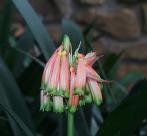
CliviaNet___________
for clivia lovers around the World
| CliviaNet Home |
| Clivia Overview |
| Cultivation |
| E-Mail and Chat |
| Clivia Society |
| Photo Gallery |
| Seed Exchange |
| Sources |
| Links |
| People |
Clivia is one of the more primitive genera of the family Amaryllidaceae. These have neither bulbs nor rhizomes, but possess an abundance of thick rope-like roots. They are evergreen, and have predominantly orange, red or salmon colored flowers. Clivia are native to southern Africa.
The most well-known species is Clivia miniata. The image shows a Belgian hybrid strain of C. miniata. In nature, C. miniata is native to KwaZulu-Natal Province and the eastern Transvaal in South Africa, and to Swaziland.
 Clivia caulescens is one of three other species of clivia, all having pendant, tubular flowers. The flower head is smaller than in C. miniata. It is native to the eastern Transvaal in South Africa, and to Swaziland.
Clivia caulescens is one of three other species of clivia, all having pendant, tubular flowers. The flower head is smaller than in C. miniata. It is native to the eastern Transvaal in South Africa, and to Swaziland.
The other known species of Clivia are Clivia nobilis and C. gardenii. C. nobilis is characterized by leaves that have a blunt or dimpled tip and rough edges. It usually has a light midrib stripe in the center of each leaf. C. gardenii blooms in late summer or in autumn, whereas the others usually bloom in late winter or in spring.
Clivia robusta Swamp Clivia
The so-called "Swamp Clivia" is unique in that it grows in streams. In appearance, it greatly resembles G. gardenii in cultivation. In its native habitat, in streams, the plant appears to stand on its roots as if on stilts.
Recently determined to be a distinct species on the basis of chromosomes and DNA, this was long known and confused with C. gardenii. The flowers are similar to those of gardenii, but this species grows in streams and wet areas. Native to the Transkei region, being found from Port St. Johns, Eastern Cape Province, in the south to the Mzimkulu River, KwaZulu-Natal, in the north. C. robusta leaves have ends that are blunter and more rounded, but still have a point at the tip, while the leaves of gardenii have acutely pointed tips. Blooms in autumn rather than in spring.
Previously known as "Robust gardenii," "Swamp Clivia," and "Swamp Forest Clivia." A preliminary name, "Clivia paludosa," became a nomen nudum due to improper publication.
See:
"A NEW SPECIES OF CLIVIA. A new species of Clivia (Amaryllidaceae) endemic to the Pondoland Centre of Endemism, South Africa" by B. G. Murray, Y. Ran, P. J. De Lange, K. R. W. Hammett, J. T. Truter and Z. H. Swanevelder, in Botanical Journal of the Linnean Society (2004), vol 146, pp 369-374.
Another Clivia species, brand new to science, was recently discovered: Clivia mirabilis.
This species was found in the Nieuwoudtville area of the Northern Cape Province, where it grows in full sun. The flowers are tubular, as are those of most of the other Clivia species. The leaves are stiff and erect, with a white midline that is tinged reddish toward the base of the leaf.
For more information on this novel Clivia, see the National Botanical Institute page: [Clivia mirabilis]
There is a natural population of the interspecific hybrid [miniata X caulescens] in southeastern Mpumalanga. Other natural hybrid clivias are probably also found in places where two species' ranges overlap.
Pollination and Seed Dispersal: ![]()